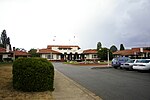Lennox Gardens

Lennox Gardens, a park in Canberra, Australia, lying on the south side of Lake Burley Griffin, close to Commonwealth Avenue Bridge and Albert Hall in the suburb of Yarralumla. Before the construction of Lake Burley Griffin a road ran through the present garden, this road being one of two main crossing points across the Molonglo River. The name of the road was Lennox Crossing from which the present garden takes its name. The northern segment of the road is still present on Acton peninsula. The garden was officially named in 1963. Lennox Crossing was named after David Lennox, an early bridge builder in NSW and Victoria. The park in its current condition was established with the filling of Lake Burley Griffin in the 1960s; however the park's history is much older, as it was part of the original Royal Canberra Golf course which is now underneath the lake. The part of the golf course which had not been flooded was named Lennox Gardens. It has a number of memorials and monuments such as Kasuga stones presented to Canberra by Japan in April 1997, a monument to Australians in the Spanish civil war, and a stone monument commemorating the centenary of Federation and the Jewish National fund. It has a Wisteria pergola sponsored by Totalcare industries in celebration of the Nara sister city relationship. Located within the park is the Canberra-Nara Peace Park (not to be confused with Canberra Peace Park), a park which symbolises the friendship between Canberra and the sister city of Nara, Japan.
Excerpt from the Wikipedia article Lennox Gardens (License: CC BY-SA 3.0, Authors, Images).Lennox Gardens
Flynn Drive, Canberra Yarralumla
Geographical coordinates (GPS) Address Nearby Places Show on map
Geographical coordinates (GPS)
| Latitude | Longitude |
|---|---|
| N -35.298333333333 ° | E 149.12194444444 ° |
Address
Flynn Drive
2600 Canberra, Yarralumla
Australia
Open on Google Maps









